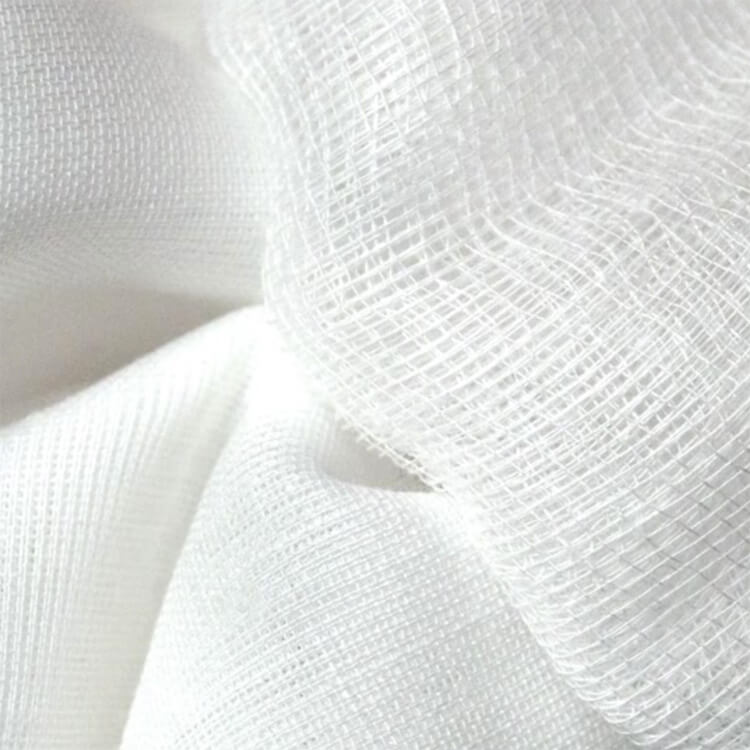What Is Cheesecloth?
Cheesecloth is a loosely woven fabric with highly twisted threads, available in various grades. Its gauze-like structure makes it suitable for food production, garment making, décor, and more. Whether you’re a culinary enthusiast or a craft lover, cheesecloth offers endless possibilities. Because it’s 100% cotton, soft, nearly lint-free, and absorbs moisture well, cheesecloth is also suitable to use for wiping and polishing cloths. It’s also great for use as a pressing cloth when ironing delicate fabrics.
Cheesecloth is widely used for décor and event decorations. It’s popular for draping at weddings and for lightweight curtains. Any grade can be used, depending on the look you want. It can be found as backdrops in theater productions, as well. It’s also used for numerous crafts and with wool batting to prevent bearding in quilts.
Cheesecloth Grades Explained
Cheesecloth comes in numerous grades. The higher the grade, the higher the thread count, making it more durable and thicker. What grade you choose depends on what you’re using it for or the look you want to achieve.
All grades have certain culinary purposes. Cheesecloth was traditionally used in cheesemaking, but it also has other uses in the kitchen, like infusing sauces and dressings onto meat, straining sauces and gravy, and draining liquids from foods. The best grade to use depends on how fine you want to strain or the type of cheese.
- Grade 10 cheesecloth is very thin with 20 x 12 threads per square inch. This construction provides good water and air flow and also makes it drape nicely. Its light and airy, gauzy look makes it particularly popular for draping at rustic weddings. Grade 10 cheesecloth is also commonly used for for spooky Halloween decorations and costumes like ghosts and mummies.
- Mid-weight cheesecloth, like grade 40 and grade 50, is very versatile. If you don’t want a weave quite as open as grade 10, but more gauzy than grade 90, these grades are a good compromise. Grade 40 has a 24 x 20 thread count and Grade 50 has 28 x 24 threads per square inch.
- Grade 90 cheesecloth is heavier and more durable with a higher thread count of 44 x 36 threads per square inch, making it almost like a solid fabric. Heavier weights of cheesecloth are used for shirts, blouses and summer skirts. The crinkly appearance makes it more appropriate for casual wear. This dense weave cheesecloth is excellent for mask-making and curtains as well. It’s ideal for cleaners, cooks, and those who need cheesecloth fabric that will last and can be used again. In the kitchen, it can be used as a substitute for butter muslin and for the making of goat cheese.
Working with Cheesecloth
Cutting
Since cheesecloth wrinkles easily and always has a crinkly texture, iron it before cutting it out. When it is flat and smooth it is easier to tame and cut a clean edge. You may find scissors with a serrated blade that will cut cheesecloth more easily.
Needles & Thread
A size 70/10, 75/11, or 80/12 universal needles are probably the most appropriate for sewing cotton cheesecloth. Use good quality polyester or cotton thread when sewing with cheesecloth.
Sewing
1. Stitches
Choose a 2mm to 2.5mm stitch length for straight seams, although a narrow zigzag might be appropriate at times. Since cheesecloth has a crepey texture, the crinkled yarns within the weave may stretch and move slightly so using a narrow zigzag (0.5mm wide by 2mm long) might work better when sewing garment seams. This will prevent the threads and stitches from breaking.
2. Seams
The cut edges of cheesecloth may have a tendency to fray so French seams are a good choice (see techniques below). A more manufactured finish created with a serger/overlocker is a quicker option.
3. Hems
Double folded and top stitched hems work well. Whether neatening the edges of cloths for wiping or hemming garments, this method conceals the raw edges so they won’t fray when being laundered. Choose a narrow, half-inch (12mm) hem for shirts and blouses or a deeper two to three-inch (5cm to 8cm) hem for a full summer skirt as the depth adds weight and improves the drape.
Techniques
1. French Seams
Place the wrong sides of the cheesecloth together with the raw edges level and sew ¼” from the edge. Trim slightly and press the seam flat with the seam allowances to one side. Turn over, and with the right sides now facing and the join right on the outer edge, pin and sew approximately ¼” from this edge. This should ensure that all the raw edges of the cheesecloth are enclosed within the French seam giving a tidy finish on the inside.
2. Decorative Finish
The loose weave of cheesecloth makes it suitable to draw threads from the cloth creating a decorative effect. Pull a band of yarns from the weave at regular intervals, for example, count 30 threads in, take 10 out, and repeat. Select a blanket-type stitch on your sewing machine and choose decorative thread and stitch either side of the band of removed stitches to secure the edges. This works well as a feature above the hem of a skirt or when used on bias panels of a gored skirt.
Ironing
Use a hot, steam iron for cheesecloth. Ironing is needed to smooth the cotton fabric and will not damage it. This also makes it ideal as a pressing cloth for protecting more delicate fabrics from the heat of the iron.
Cheesecloth Product Spotlight Video
Ready to Start Your Cheesecloth Project?
Whether you’re planning a culinary masterpiece, a creative craft, or looking to add a touch of elegance to your décor, our variety of grades and quantities of cheesecloth has something for everyone. From the light and airy Grade 10 to the durable Grade 90, each cheesecloth offers unique possibilities. Explore our collection and discover the perfect match for your needs.

